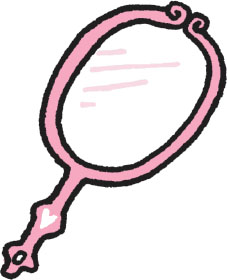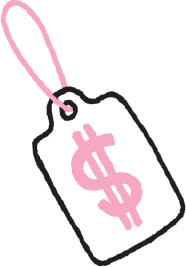8
The ABCs of Skin-Care Shopping:
Finding the Right Products for You
Now that you’re thoroughly pumped to start your skin-care routine, where do you start? You start shopping.
But before you go all Cher Horowitz on beauty products, be warned: Shopping for skin care can often feel overwhelming because of the choices and the prices. Do you need an essence, a sleeping pack, or a sheet mask? Wait, do you need all three? Should your oil cleanser come with a pump or in balm form? Oh my God, you forgot about eye cream!
Or it can be underwhelming if you’re expecting your skin to improve, but end up with a product that causes more congestion on your face than you started with—a one-way ticket to bummer city.

So instead of grabbing your credit card and heading out blind, let’s do some soul searching and assess the best way to go about purchasing skin-care products for you. I’m also a firm believer that you can respect your skin and your wallet at the same time, so let’s make smart choices here, people!
First things first: Refresher course! Remember when I told you that you shouldn’t just assume that what your two best friends are using will suit you? No matter how much they rave about a product, it just might not be right for you. Your skin is uniquely yours.
After speaking with dermatologists in Korea and R&D specialists of top Korean beauty companies and pairing their info with my own esthetician knowledge, I put together some guidelines on what conditions you might see on your face and how to use that information to help determine your skin type. I stress the word “guideline” because obviously there’s no perfect formula and your skin’s conditions can change depending on several different factors. Environmental conditions, stress levels, allergies, and diet are just some of the things that play a role in your skin condition and keep it constantly changing.
This is why my time in front of the mirror is not limited to applying makeup or trying on different shoes. I take time to really analyze my skin and see how it’s doing. Don’t be afraid to get up close and personal with the mirror after you cleanse your face. Take the time to really look at your skin using not only your eyes, but your fingers, too, as they can feel things your eyes may not be able to catch! Once a week it’s good to say ’sup to your skin and see what’s new: A flaky nose bridge? A rough and bumpy chin? An itchy, scaly patch above your right eye? The sooner you catch things like these, the sooner you can treat them and prevent them from spreading.

Charlotte’s Skin Chart: What’s Your Type?
Signs You Have NORMAL Skin
• You have little pores along the T-zone
• You rarely experience breakouts
• You experience a slight oily shine at the end of the day
• You rarely are sensitive to products
Here’s the deal: You’ve basically hit the skin jackpot. Almost anything you put on your face, whether it has a heavy, medium, or light consistency or a formulation that’s more oil-in-water or water-in-oil, is going to work fine for you. You’ve also probably skated through life with few blemishes, and your skin is relatively soft, bright, and firm.
Skin-care focus: Maintain and protect your healthy skin through cleansing, hydration, and sun protection.
Signs You Have DRY Skin
• You have very few visible pores and blackheads
• You have flaky or rough skin
• Your skin constantly feels tight or itchy
• You don’t experience an oily shine
Your skin is flaky and rough and it needs to be nourished! Apply products with more of an oily, emollient base to protect your skin’s barrier function. With your skin, you’re more prone to visible signs of aging (fine lines and wrinkles). The upside of dry skin? You have small pores, you don’t have to deal with an oil slick forehead, and you rarely have blemishes or acne.
Skin-care focus: Be vigilant about moisturizing and hydrating. Look for humectants that will bring back moisture to the skin and support a healthier barrier function.
Signs You Have OILY or ACNE-PRONE Skin
• You frequently experience breakouts and blackheads
• You have dilated or enlarged pores across the face
• You experience an oily shine and can feel oily residue when you touch your skin
• You are currently experiencing a breakout
Unlike your dry-skinned counterparts, your skin has lots of oil. This means your barrier function will be protected with natural oils, so you’ll be looking youthful for longer. Unfortunately, excess oil also means the danger of acne breakouts! Gel creams (water-based formulas) work well with your skin type. Also, oil cleansers work wonders to gently remove sebum in the morning and at night.
Skin-care focus: Avoid clogged pores and control oil production by exfoliating with an ingredient such as salicylic acid. Use lightweight gel-type, water-based products to keep from adding oil to your skin and avoid emollients such as shea butter and lanolin. Finish off with oil-free makeup.
Cleansing is important here, especially if you have acne-prone skin. Use a gentle oil cleanser to remove your natural sebum. Don’t use harsh exfoliators (with granules) over active breakouts. You’d benefit from anti-inflammatory and antibacterial ingredients such as tea tree oil. Make sure you protect with sunscreen, as acne eruptions are technically wounds and are subject to post-inflammatory pigmentation, meaning that they can darken permanently from sun exposure.
Signs You Have HORMONAL ACNE
• Your acne doesn’t respond to topical treatments
• Your acne is primarily below the cheekbones and underneath the jaw
• Your acne is cystic, which means pimples are deeply embedded in the skin and painful
• Your acne flares up the week before or the week of your period
If you think this might be your case, talk to your dermatologist about having your hormone levels checked, or speak to an herbalist or nutritionist who can help you identify lifestyle tweaks to help find balance in your body and skin.
Signs You Have COMBINATION Skin
• You have visible pores along your T-zone (nose, forehead, and even some on your cheeks)
• You are oily around the T-zone, but rough and dry elsewhere
• Your skin is really indecisive—you’ve had to deal with flaky, dry patches and acne at the same time
Skin-care focus: Don’t be afraid to use targeted treatments for different areas of your face. If you have an oily T-zone, use a BHA exfoliator and lightweight gel-type moisturizer there and a creamier, oil-based moisturizer in the dryer areas.
Signs You Have SENSITIVE Skin
• Your skin burns or itches when exposed to certain products or environments
• Your skin turns red or becomes bumpy easily
I would recommend making sure the products you use don’t contain fragrances or dyes, both of which can be irritating. Avoid products that are highly alkaline and strong chemical exfoliators. Also, if you can, first do a patch test of a product on your arm before purchasing.
Skin-care focus: Whether your skin is oily or dry, your first priority is to find gentle skin-care products that don’t contain added fragrances or abrasive scrubs to avoid breakouts, redness, and irritation.
Now . . . What Products Do You Buy for Your Skin Type?
Whether you’re at your local store or browsing online, you’ll be confronted by an intimidating number of different brands with beautiful, colorful bottles competing for your attention. What’s the first thing to consider? You’re going to need a clean canvas. This means that you need to go in with no preconceived notions about skin care. It’s time to bust some myths about skin care that are the result of years of marketing mumbo jumbo.

The Price
It’s simply not true that the most expensive product is the best skin-care product. The beauty market in Korea is proof that you can buy well-formulated goods at really affordable prices. Sometimes the expensive brands are expensive not because of the ingredients they’re using or because of the research that goes into their products, but because they have a huge marketing and celebrity spokesperson budget they have to recoup.
Your Sex
Boys, your only option is not a male skin-care line. I smile when a girlfriend tells me that her boyfriend uses her skin-care products. Dave and I frequently use the same products, and it’s completely fine because, again, guys should also be purchasing based on skin type (not by a bottle saying that the product is for men!).
It’s true that some men may have a bit more dry, irritated skin around the mouth and chin from shaving facial hair. There are even those who say men produce more oil than women, but in general, skin is skin and not everyone fits in a mold. Most of the time, the only difference is in the packaging and fragrance. Some dudes just want manlier-looking and -smelling products on their shelves, and that’s fine—it’s just good to know your options aren’t that limited.
Your Age
Nope! Don’t go there. Many people believe their age is the most important factor when deciding what products to try. The right products for you are not formulated by what age you are, but what conditions you see on your skin. Are all forty-year-olds dealing with the same skin issues? Nope. So you shouldn’t buy a line based on what age group you belong to, case closed. Age ain’t nothing but a number.
Dermatologist Recommended
It sounds legit and official, but this phrase can be used even if only one dermatologist gives a product a thumbs-up—and that dermatologist could have been paid for the endorsement. The assurance we get that a product has been backed by a doctor undoubtedly has some sway, but don’t be tricked into thinking it means the product is magical or somehow right for you.
Hypoallergenic
This word is commonly found on products that claim to produce fewer allergic reactions. But there are currently no FDA regulations for hypoallergenic formulas, so a company can use the term however it pleases! Sorry, sensitive skin types, you don’t have it easy—it’s better for you to learn what irritants cause you to break out and avoid them by looking at the ingredients list on the back of the bottle. Even dermatologists say the term has very little meaning.
Cosmeceutical
Another sneaky term, it means the product has drug or medicinal benefits, but the FDA has no regulations in place, so again anyone can slap that claim on a bottle. If it really, truly had medicinal benefits, then it would be a drug, not a cosmetic. If you come across anything that’s labeled as a “hypoallergenic dermatologist-recommended cosmeceutical,” you’ve basically hit the skin-care b.s. jackpot.
Natural, “Chemical-Free” Products
It sounds mighty appealing to go for all-natural skin care, but is it truly better? In a perfect world, every natural ingredient is better for you than synthetic, but we live in an imperfect world where plenty of natural things are extremely irritating to skin! Take poison ivy, for example, or even just grass! Many synthetic preservatives work better to stabilize the product and are effective in preserving it for longer periods of time. If you are gung-ho about using an all-natural formula that is preservative-free, be aware that its shelf life will be incredibly short, and you might have to chuck it before you’ve had a chance to use it up.

On that note, chemical-free products are highly sought after. I know the word “chemical” sounds scary, but did you know that you yourself are made up of millions and millions of chemicals? So it’s not black and white. The best recommendation is always to understand what ingredients work and don’t work for you.
When should you throw out products?
Skin-care products don’t last forever. Oxygen, water, and bacteria from your icky fingers digging around the jar all make sure of that. Look for the period-after-opening (PAO) symbol of a little open jar on the packaging and you’ll see a number next to an “M” that signifies how many months a product is good for after it’s been opened. While every product you use will differ (especially if it’s in jar packaging vs. pump), my personal rule is that skin-care products should be thrown out within one year after they’ve been open. Attention, hoarders: Products that have not been opened will be stable for two to three years.
#sokosecret: Many Korean brands put the manufacturing date on their products instead of the expiration date. Sometimes people freak out when they see this date and think, This product is already expired! As Korean brands become more global, some have started to switch to the expiration date method. If you see the Korean characters “![]() ” after the date, that means the date signifies the manufacturing date, not the expiry.
” after the date, that means the date signifies the manufacturing date, not the expiry.
Is it okay to mix and match brands?
Absolutely. Never feel as if you have to use one line to get the best results (that’s a popular marketing tactic, so don’t fall for it!). There have been so many cases, in my experience, where a certain brand has an amazing facial oil but a terrible moisturizer. Mix and match to your skin’s content.
Why Korean products?
I would never say you have to use Korean beauty products in order to get healthier, more youthful-looking skin. As I’ve said before, many Western products are popular in Korea. What is most important is arming yourself with the right knowledge and investigating the proper product for you. It might be that it’s made in Korea, or it might not.
But there’s a reason so many beauty trends and products made in Korea are influencing the world in terms of product offerings and even key ingredients. The country is incredibly beauty focused and has a knowledgeable consumer base that has transformed the industry as a whole, keeping companies on their toes to meet the demand for impressive, high-quality products. Here are some of the reasons why Korea is a leader in skin care and beauty:
• Great formulas with affordable prices. Koreans are serious about their skin care. They know what they want and how they want it, and they don’t want to pay a fortune for it. That makes Korean cosmetic companies work harder to create only the best products at reasonable price points. That’s why large global cosmetic companies look to the Korean consumer market to test their products. If it does well in Seoul, it’ll do well elsewhere.
• Innovative research and development. As explained above, Korean cosmetic companies really value consumer opinions, so there’s an intense focus on research and development to satisfy customers’ stringent standards and needs. The result? An explosion of cutting-edge and effective products such as cushion compacts, sheet masks, and fermented skin-care products.
• New and powerful ingredients. As I said before, it’s not about price, it’s about well-formulated products that are gentle yet effective. Korean consumers consistently provide feedback that they have sensitive skin, so the companies focus on using well-tested and nourishing ingredients to moisturize and treat skin. It’s not about immediate results, but consistent use that will bring skin to a healthier state.
• Well-designed products that look awesome. Korean cosmetic companies have really upped the ante on aesthetically pleasing packaging and design, and you’ll find everything from gwiyeowo (“cute”) to sophisticated elegance. If you’re going to use a product every morning and night, it might as well look pleasing to the eye and it sure makes skin care and beauty as enjoyable as it is beneficial! Again, companies look to consumer feedback to see how they can improve the user experience. They’re willing to be creative and take risks, so cue the panda hand cream.
#sokosecret: Fermented skin care is the latest in Korean skin-care innovation. Fermenting skin-care ingredients is beneficial because the process of converting fruits, plants, herbs, and yeast yields skin-loving amino acids and antioxidants that absorb more easily. Brands like Su:m37 and Goodal focus on using fermented ingredients in their formulas.
Want to hear about my favorite brands? Head on over to chapter eleven for a complete guide to skin-care shopping in Seoul!
Ingredients to Be Excited About
| Ingredient | What It Is | What It Does |
| Hyaluronic Acid | Humectant, moisturizer | Adds moisture |
| Glycerin | Humectant, moisturizer | Adds moisture |
| Honey | Anti-inflammatory, antioxidant | Heals wounds, fights signs of aging |
| Ceramides | Moisturizer | Restores moisture, improves skin texture |
| Urea | Humectant, moisturizer | Adds moisture |
| Glycolic Acid | Chemical exfoliant (AHA), humectant | Exfoliates, adds moisture, brightens skin |
| Lactic Acid | Chemical exfoliant (AHA), humectant | Exfoliates, adds moisture, brightens skin, reduces wrinkles |
| Kojic Acid | Melanin inhibitor | Decreases hyperpigmentation |
| Niacinamide | Antioxidant, melanin inhibitor | Fights free radicals; hydrates; improves elasticity; decreases hyperpigmentation, redness, and fine lines/wrinkles |
| Salicylic Acid | Chemical exfoliant (BHA), anti-inflammatory, antibacterial | Removes sebum, treats acne |
| Benzoyl Peroxide | Antibacterial | Treats acne |
| Mandelic Acid | Chemical exfoliant (AHA) | Decreases hyperpigmentation, exfoliates, adds moisture |
| Vitamin A | Antioxidant | Treats acne, reduces wrinkles, decreases hyperpigmentation |
| Vitamin C (other forms: calcium ascorbate, ascorbic acid, ascorbyl palmitate, Ester-C) | Antioxidant, melanin inhibitor | Stimulates collagen production, adds moisture, brightens skin |
| Vitamin E | Antioxidant | Adds moisture, decreases hyperpigmentation, fights free radicals |
| Caffeine | Antioxidant | Reduces redness, fights free radicals |
| Red Raspberry Extract | Antioxidant, antibacterial | Reduces redness |
| Zinc Oxide | Physical sunscreen | Protects from UVA and UVB rays |
| Titanium Dioxide | Physical sunscreen | Protects from UVA and UVB rays |
| Ginseng | Antioxidant | Stimulates collagen production |
| Snail Secretion Filtrate | Moisturizer | Hydrates, stimulates collagen production |
| Saccharomyces Ferment Filtrate | Antioxidant, anti-inflammatory | Hydrates, fights signs of aging, brightens skin |
| Green Tea | Antioxidant | Hydrates, fights signs of aging |
| Tea Tree Oil | Antibacterial, anti-inflammatory | Treats acne |
Buyer Be Smart
So it’s time to start shopping. But before you begin, remember to be wary of falling into the trap of believing that a particular product will magically give you perfect skin. Keep in mind it takes time to see results. That means being knowledgeable about ingredients and using the products you need to consistently support your skin’s natural defenses and improve whatever conditions you see. The goal here is not perfect skin—there is no such thing as perfect skin!—but to get your skin the healthiest it can be.
Even in Seoul, when I see someone whose dewy complexion looks flawless, I just remind myself that it probably just looks perfect. She might have blackheads on her nose, a flaky chin, and a shiny forehead, but she knows what to do and what to use to control it. Just like you. So let’s go shopping.
SKIN STORIES: Paul Kang
SENIOR VICE PRESIDENT OF AMOREPACIFIC’S SKINCARE RESEARCH DIVISION
In the United States, skin care accounts for about 20 percent of the beauty market, but in Korea, it’s more around 50 percent. Prevention is the biggest segment of skin care in Korea. Consumers are of two minds: They hope that products will work to treat and correct, but don’t really expect them to work miracles and turn back time, so they focus a lot on preventing skin problems before they appear. Korean consumers really believe that they will see big results if they continually care for their skin for a long time.
Consumers don’t care what information we put on the bottle about what a product does. Instead, they will look for reviews on the Internet, or listen to what their friends are saying about a product and then test it themselves. The makeup category is growing in Korea, and a lot of that is consumers wanting products that do more than one thing—like cushion compacts, which is makeup that also protects the skin. Korean women spend a lot of time and effort on skin care, but they want their makeup routine to be as quick and easy as possible.
The two most important determining factors in what products you should use are your genetic makeup—your skin type—and your climate. People in California will use different products from people in Singapore. A lot of Koreans have sensitive skin, so even when something is formulated and tested on Caucasian skin, it can still be irritating for a lot of Koreans. And even though our consumers want antiaging products, they still want them to be very safe. If they are not satisfied with a new product, then it is gone.
